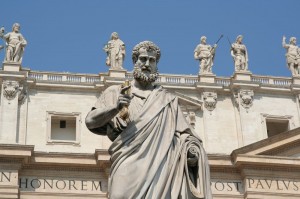 [1]For the average layman, much, if not the vast majority of discussions about Catholic traditionalists, Vatican II, and the Reform of the Reform, exists solely online and in the realm of the Catholic zeitgeist. Yet from time to time, we Americans are privy to a real-life disputes amongst the various factions of Catholics.
[1]For the average layman, much, if not the vast majority of discussions about Catholic traditionalists, Vatican II, and the Reform of the Reform, exists solely online and in the realm of the Catholic zeitgeist. Yet from time to time, we Americans are privy to a real-life disputes amongst the various factions of Catholics.
All politics is local, and that goes for Catholic politics as well.
These kind of disputes follow a common narrative. A traditionalist-leaning clergy member is brought into a parish, and begins instituting various liturgical and sacramental changes. Often it is new policies banning Eucharistic ministers, girl altar servers, and casual apparel at Mass. Are these policies reasonable? Perhaps, perhaps not. It doesn’t really matter. What matters is a toxic mix of undiplomatic clergy and uncatechized laity leaves the parish community in disarray.
Many long-time members leave. And not just the parish, but the Catholic Church entirely. Eventually, a friendship priests and the faithful laity who remain fosters, and wounds heal. But not after very serious financial and spiritual damage.
This is what happened in St. Mary’s Parish in Platteville, Wisconsin. In 2010, Madison Bishop Robert Morlino brought in three priests from the Society of Jesus Christ the Priest to lead the parish. After the priests made several admittedly “abrupt [2]” changes, much of the laity decided to revolt.
A reportedly 469 of the church’s approximately 1,200 members at the time signed a petition asking Bishop Morlino to immediately remove the priests. Parishioners alleged that the they were not following Vatican II. Some decided to attend Mass elsewhere. Donations plunged. By 2012, the necessary fundraising efforts to keep the church’s 77-year-old parochial school open failed.
Bishop Morlino, who handled the situation as best he could, summed up the dispute in his letter thusly:
“I think, however, that at the end of the day, the Catholic faith is being taught according to the proper understanding of the Second Vatican Council, and that what remains are personal likes and dislikes, along with inflated rumors and gossip, some of which may even rise to the level of calumnious inciting of hatred of your priests, the faith, and myself. For these likes and dislikes, gossip, and hurt feelings, the Catholic faith is rejected and a school is closed.”
A somewhat similar situation is currently playing out in the Archdiocese of San Francisco. Archbishop Cordileone isn’t a traditionalist, to my knowledge, but he his leadership style is more conservative. Earlier this year, the Archbishop “caused dismay among teachers, students, parents, and the public earlier this month when it introduced morality clauses into four Catholic high school handbooks as well as teacher labor contracts.”
This lead to 100 San Franciscans self-described as “committed Catholics inspired by Vatican II” to take out a full page ad in the San Francisco Chronicle asking Pope Francis to remove Cordileone’s resignation and replace him with someone committed to “our values and your teachings.” Of course, that’s not going to happen. But that doesn’t stop them from trying.
Now if you ask me who’s side I’m on in these two disputes, I’m going to support the priests and bishops. Many of the protesting laity in these two situations don’t even support significant portions of Catholic teaching. They use a perverted interpretation of Vatican II as the foundation of their dissent.
We will likely see more clergy v. parishioner feuds in the future, especially as the current crop of traditionalist seminarians move into leadership positions. The priest who grew up in the traditionalist ghetto, or even a just a more conservative community, will be in charge of pastoring hundreds, if not thousands of Catholics who know little of the Catholic faith but play vital roles in their local parish.
How should they be lead? Is instituting some sort of Benedict Option from above, driving out all cafeteria Catholics from the parish or diocese, really the answer? I would say that avoiding the situations in Platteville and San Francisco in the future is ideal, and doing so requires much more strategy on the part of conservative and traditionalist priests.
In this day and age, there is no longer an excuse for not anticipating a revolting laity when implementing abrupt liturgical or moral corrections. But it keeps happening.
I think one of the most pressing questions at this point in American Catholic history is this: Can traditionalist and deeply conservative priests (however you might define them) live by, worship with, and lead cafeteria Catholics? I think they have to. But how?